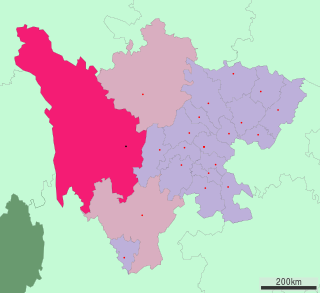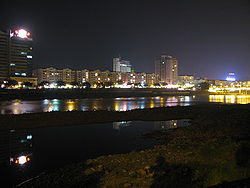
Dujiangyan is a county-level city of Sichuan Province, Southwest China, it is under the administration of the prefecture-level city of Chengdu. Its north-west region forms a border with southern Ngawa Tibetan and Qiang Autonomous Prefecture. It has an area of 1,208 km2 (466 sq mi) and had a population of 710,056 in 2020.

The Tea Horse Road or Chamadao, now generally referred to as the Ancient Tea Horse Road or Chamagudao was a network of caravan paths winding through the mountains of Sichuan, Yunnan and Tibet in Southwest China. This was also a tea trade route. It is also sometimes referred to as the "Southern Silk Road" or "Southwest Silk Road."

Neijiang is a prefecture-level city in the southeast of Sichuan province, People's Republic of China. It is located on the Tuo River, midway between the two major cities of Chengdu and Chongqing, is a transportation and food-processing center. The population of the entire prefecture was 3,140,678 at the 2020 census, and the population of the built-up (metro) area was 1,179,140 in the 2 urban districts of Shizhong and Dongxing.

Guangyuan is a prefecture-level city in Sichuan Province, China, bordering the provinces of Shaanxi to the northeast and Gansu to the northwest. The city has a population of 2,305,657 as of the 2020 census.

Garzê Tibetan Autonomous Prefecture, often shortened to Ganzi Prefecture, is an autonomous prefecture in the western arm of Sichuan province, China bordering Yunnan to the south, the Tibet Autonomous Region to the west, and Gansu to the north and northwest.

Zhaotong is a prefecture-level city located in the northeast corner of Yunnan province, China, bordering the provinces of Guizhou to the south and southeast and Sichuan to the northeast, north, and west.

Guang'an is a prefecture-level city in eastern Sichuan province. It is most famous as the birthplace of China's former paramount leader Deng Xiaoping. Guang'an lies between the hills of central Sichuan and the gorges area of the east. Guang'an is the only "Sichuan Chongqing Cooperation Demonstration Zone" in Sichuan and the nearest prefecture level city from the main city of Chongqing. It has been incorporated into the one-hour economic circle of Chongqing. Because of its strategic location, it is called the "Gateway to Eastern Sichuan". Its population, as of the 2020 census, was 3,254,883, of whom 976,370 lived in the built-up area made up of two urban districts.

Dazhou is a prefecture-level city in the northeast corner of Sichuan province, China, bordering Shaanxi to the north and Chongqing to the east and south. As of 2020 census, Dazhou was home to 5,385,422 inhabitants whom 1,850,869 lived in the built-up area made of 2 urban districts.

Kangding, also called Tachienlu and Dartsedo, is a county-level city and the seat of Garzê Tibetan Autonomous Prefecture in Sichuan province of Southwest China. Kangding is on the bank of the Dadu River and has been considered the historical border between the Kham region of Tibet and the Sichuan region. Kangding's urban center is called Lucheng, which has around 134,000 inhabitants.

Garzê County or Kardze County, called Ganzi County in Chinese, is one of the 18 subdivisions of the Garzê Tibetan Autonomous Prefecture, in northwestern Sichuan province, China. The Yalong River passes just south of the town Garzê, also known as Ganzi, the capital town of the county, which has some 16,920 inhabitants (2010), many of them ethnic Tibetans, and is famous for its Tibetan lamasery. Historically, it is part of the Tibetan cultural region of Kham and now defunct province of Xikang. It lies on the northern section of the Sichuan-Tibet Highway.

Qionglai is a county-level city of Sichuan Province, Southwest China, it is under the administration of the prefecture-level city of Chengdu. It is located around 60 kilometres (37 mi) from downtown Chengdu. The city is located on the western edge of the Sichuan Basin and in the foothills of the Qionglai Mountains that bound the basin from the west and is bordered by the prefecture-level city of Ya'an to the west.

Deqin County is county of Diqing Tibetan Autonomous Prefecture, located in northwest Yunnan province, China.

Jiange County is a county of Sichuan Province, China. It is under the administration of Guangyuan city. The history of Jiange County as a county division goes back around 1700 years. The county has historically been a junction between the north and south of Western China, through the Jianmen Pass. It is a popular tourist destination in Sichuan.

Yingjing County is a county in the west-central part of Sichuan Province, China. It is under the administration of Ya'an city.

Shimian County is both the southernmost and westernmost county in the prefecture-level city of Ya'an, Sichuan Province, China. The county seat, Miancheng Subdistrict (棉城街道), and the neighboring town, Xinmian (新棉镇), are often together referred to as Shimian. As of the 2010 census, Shimian County has a population of 123,600. The G5 Beijing–Kunming Expressway now passes through Shimian along the route between Kunming and Chengdu.

Baoxing County is one of the seven counties under the administration of Ya'an City, in west-central Sichuan Province, China, located along the upper reaches of the Qingyi River. It is a vital geopolitical crossroad, transportation hub, and most importantly, a biodiversity hotspot and type locality for many endangered species, including giant panda, dove tree, Chinese thrush, golden snub-nosed monkey and Oreolalax popei. UNESCO named Baoxing as a part of the World Heritage Site, the "Sichuan Giant Panda Sanctuaries - Wolong, Mt Siguniang and Jiajin Mountain" in 2006.

Dayi County is a county of the City of Chengdu, capital city of Sichuan, China. It is Chengdu City's westernmost division, bordering the prefecture-level divisions of Ya'an to the south and the Ngawa Tibetan and Qiang Autonomous Prefecture to the north.

Yucheng is a county-level district of Ya'an, a prefecture-level city in Sichuan Province, China. The district contains the city centre of Ya'an as well as the surrounding countryside.

The Lushan earthquake or Ya'an earthquake occurred at 08:02 Beijing Time on April 20, 2013. The epicenter was located in Lushan County, Ya'an, Sichuan, about 116 km (72 mi) from Chengdu along the Longmenshan Fault in the same province heavily impacted by the 2008 Sichuan earthquake. The magnitude of the earthquake was placed at Ms 7.0 by China Earthquake Data Center, Ms 7.0 by Russian Academy of Sciences, Mw 7.0 by Geoscience Australia, Mw 6.6 by the United States Geological Survey (USGS), Mw 6.6 by the European Alert System (EMSC) and Mj 6.9 by the Japan Meteorological Agency (JMA). 1,815 aftershocks have been recorded as of 00:00 (UTC+8h) April 22.

The G4218 Ya'an-Yecheng Expressway, commonly referred to as the Yaye Expressway, is an expressway that will traverse the entirety of Tibet and link Ya'an in Sichuan to Yecheng in Xinjiang.


























